
views
X
Research source
Using Tabs to Fret Notes and Chords
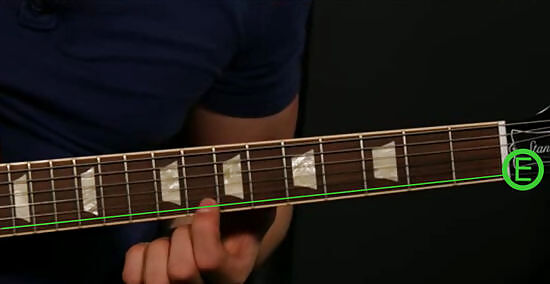
View tab notation as a representation of the guitar's strings. A tab is usually written using six horizontal lines, each corresponding with a string on the guitar. The bottom line represents the lowest, thickest string, while the top string represents the highest, thinnest string. For standard tunings, this means that the lines will represent, from the bottom up, the low E, A, D, G, B and high E strings. E----------------------------||(Thinnest string) B----------------------------|| G----------------------------|| D----------------------------|| A----------------------------|| E----------------------------||(Thickest string)
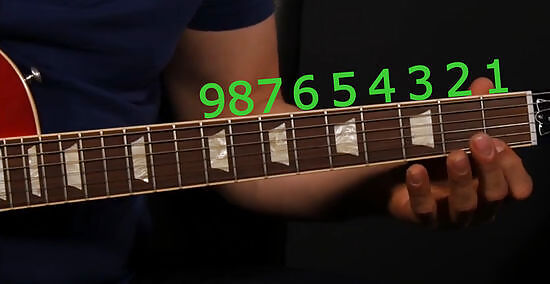
Use the numbers on the tab to fret spaces on the neck. Unlike normal musical notation, guitar tabs don't tell you which notes to play. Instead, they tell you where to put your fingers. Numbers on the lines correspond to frets on the fretboard. Each number represents a specific fret on the line it's written on. For instance, a "1" on the bottom line means to fret the first fret of the lowest string and play that note. If the number is greater than 0, (1, 2, 3, 4, etc), then press your finger on that fret when you play, with "1" being the fret closest to the stock and fret numbers increasing as you move towards the guitar's body. If the number is 0, then pluck the open string without fretting any notes.

Play vertically stacked numbers at the same time. When reading tabs, many times, you'll come across numbers that are aligned vertically. These are chords. Fret every note in the chord as written, then play the notes all at the same time. You'll get a fuller sound then. You might see the chord name written as well. See Example 2 below.
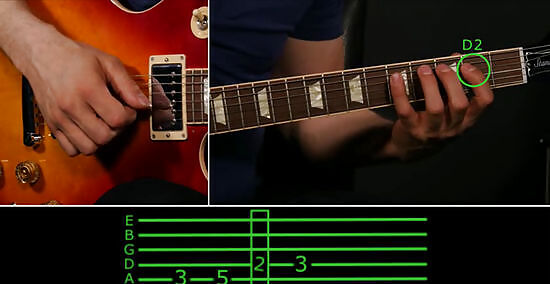
Proceed from left to right. Tabs are read like sentences in a book - read them from left to right, across the page, dropping down to the next line only when you've reached the end of the previous. Play the notes and chords in sequence as you read them from left to right. Note that most (but not all) tabs don't display the rhythm with which you should play the notes in the tab. They may break the tab into measures (usually signified by vertical lines in the tab between measures, but they won't tell you the rhythm of the notes within the measures. In this case, it's best to listen to the song while you read the tab to find the beat. Some advanced tabs do count out the beat for you - this is usually done by including rhythmic markings along the top of the tab notation. Each marking is vertically aligned with a note or a rest to give a sense of how long the note or rest lasts. Typical rhythmic markings include: w = whole note h = half note q = quarter note. e = eighth note. s = sixteenth note. Sometimes & markings are included to show that a note or rest lies on the "and" of a certain beat. A dot after the rhythm marking means the corresponding note or rest is dotted. For instance, q. = dotted quarter note. For rhythm basics, see How to Read Music

Look for lyrics or chord changes. Many songs have guitar parts made up solely (or mostly) of chords. This is especially true for rhythm guitar parts. In this case, the tab may forgo typical tab notation in favor of a simplified list of chord changes. These chords are almost always written in standard chord notation (Amin = A minor, E7 = E dominant 7, etc.) Simply play the chords in the order that they're listed - if it's not noted otherwise, try playing one chord per measure, but if the changes don't sound right, listen to the song for the strumming pattern. Sometimes, these chord changes are printed above the lyrics of the song to give you a sense of when these chords are played, as in this snippet from a tab for The Beatles' "Twist and Shout:" (A7)...................(D)...............(G)............(A) Well shake it up baby, now (shake it up baby)
Reading Special Symbols
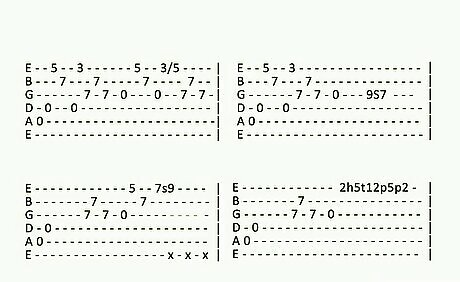
Look for additional symbols in the tab. As you can see in the example above, many tabs aren't just collections of lines and notes. Tabs use a wide variety of special symbols to tell you how to play the notes in the tab. Most symbols refer to specific playing techniques - to make a song sound as much like the recording as possible, pay attention to these special markings.
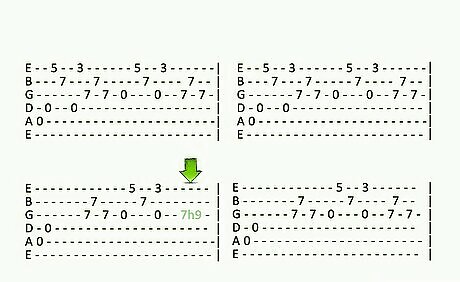
Learn the symbol for Hammer ons. In a tab, an "h" inserted between two notes (e.g. 7h9) means to perform a hammer on. To hammer on, play the first note normally, then use a finger on your fretting hand to tap down on the second note without using your strumming hand to pluck the note. Sometimes "^" is used instead (e.g. 7^9).
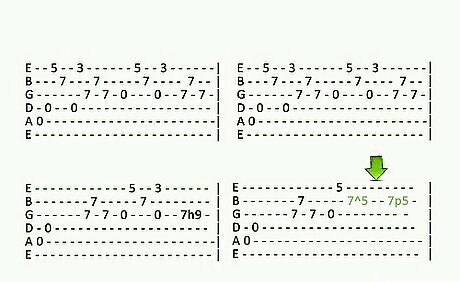
Learn the symbol for Pull offs. - A "p" inserted between two notes (e.g. 9p7) means to perform a pull off, which is essentially the opposite of a hammer on. Pluck the first note while using another finger to fret the second note. Then, quickly lift the finger fretting the first note. The second note will sound. As with hammer ons, sometimes "^" is used instead (e.g. 9^7). In this case, know to perform a pull off if the second note is lower and a hammer on if the second note is higher.
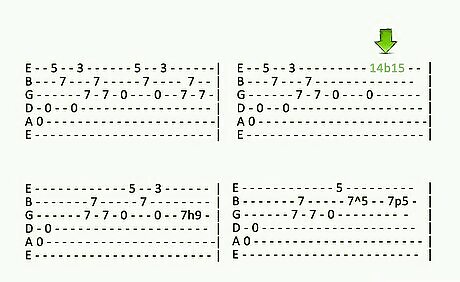
Learn the symbol for string bends. If a "b" is inserted between two fret numbers (e.g. 7b9), fret the first note and bend it up until it sounds like the second. Sometimes the second number is in parentheses, and occasionally the "b" is omitted altogether. If there is an "r" it denotes what the note should be released to (e.g. 7b9r7).
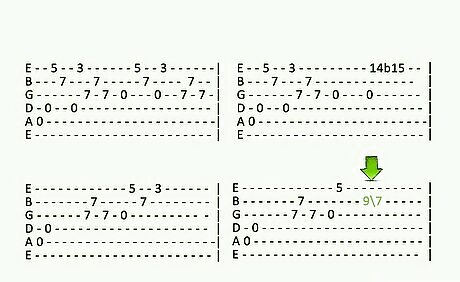
Learn the symbols for slide techniques. Perform a basic slide by striking a note, moving your finger up or down a string without releasing it from the fretboard, then striking another note. An ascending slide is marked by a forward slash "/" and a descending slide is marked by a backwards slash "\" (e.g. 7/9\7). A lowercase "s" usually means to perform a legato slide. This is like a normal slide, but you only strike the first note with your pick. Let your target note sound simply from the motion in your fret hand.Read Guitar Tabs 10b1.jpg There is debate among guitarists over whether a light pick strike is appropriate for the target note. The most important thing is to remember to leave no gap between notes. Shift slides are signified by an uppercase "S." In this case, strike the target note without striking the initial note of the slide.Read Guitar Tabs 10b2.jpg
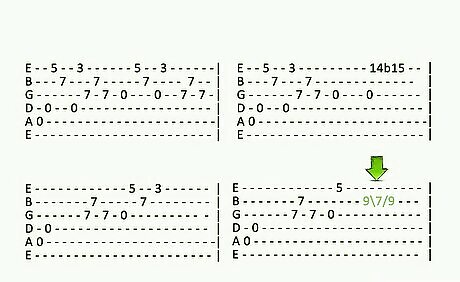
Learn the symbols for tremolo bar techniques. If your guitar has a tremolo bar, (also known as a "whammy bar" or "vibrato bar") follow these symbols to achieve some remarkably out-there effects. If you see a "\n/," where n = some number, perform a tremolo bar dip. Quickly hit and release the bar to dip the note's pitch. The number between the slashes gives an indication of the pitch you should dip to - dip the pitch by "n" semitones (a semitone is the same as the pitch between two adjacent frets.) For instance, "\5/" means to drop the pitch by 5 semitones, which will be the same tone as 5 frets below the original note.Read Guitar Tabs 11b1.jpg If you see a "\n," where n = some number, fret note "n," then strike it and depress the tremolo bar deeply to dramatically drop the pitch. If you see "n/," raise the tremolo bar up after striking note "n" to raise the pitch. On some guitars, you can also put your bar in "inverted" position first so that hitting the bar raises the pitch rather than lowers it. If you see "/n\," perform a tremolo bar inverted dip by first depressing the tremolo bar, then raising it. As above, this also works in inverted position.Read Guitar Tabs 11b4.jpg
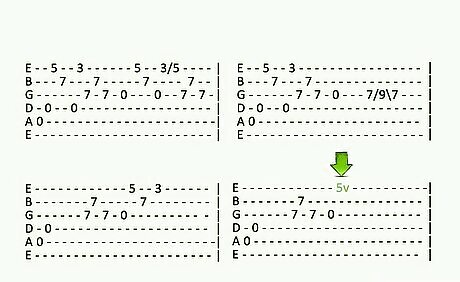
Learn the symbol for vibrato. Look for "~" or "v". If you see these symbols, perform vibrato on the preceding note. Strike the note, then use your fretting hand to rapidly bend and unbend the string, vibrating the pitch of the note.

Learn the symbols for muting techniques. Several tab symbols indicate different methods for giving notes a "muted" sound. If you see an "x" or a dot below the number, mute the string. Lay your fretting hand finger(s) across the designated strings so that when you strike them they produce a dull, clicking sound. Several "x" in a row, on adjacent strings, indicates a rake - just mute more than one string at once.Read Guitar Tabs 13b1.jpg If you see "PM," play using palm muting. For standard right-handed guitar playing, gently lay the edge of your right palm across the strings near the guitar's bridge. When you strike the notes (with the same hand as is providing the mute), you should hear the tone of the note, but with a subdued, dead quality. Move your hand slightly up the strings toward the neck to deaden the notes more. Read Guitar Tabs 13b2.jpg
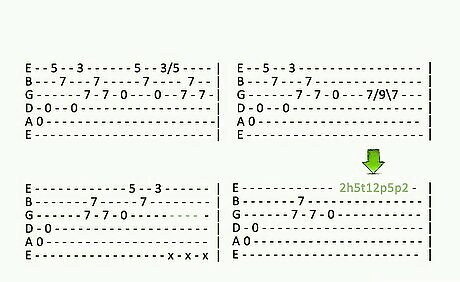
Learn the symbol for tapping. Tapping is usually represented by a "t." If you see a "t" in a string of notes, (e.g. 2h5t12p5p2) use one of the fingers on your picking hand (usually your right hand) to tap down hard on the indicated fret. This is a useful technique for making very rapid, fast changes in pitch.

Learn the symbols for harmonic techniques. Guitar tabs differentiate between several different techniques for playing harmonics - bell-like tones created by special fretting techniques. For natural harmonics, the fret is surrounded by "< >" (e.g. <7>). If you see this, lay a fretting finger across the metal line at the right of the fret, not the middle of the fret. Then, strike the string for a clear bell tone.Read Guitar Tabs 15b1.jpg Pinch harmonics are signified by surrounding the fret number in brackets (e.g. [n]). To perform a pinch harmonic, strike the note with your pick hand while your pick hand thumb is also touching the note. Use vibrato from your fret hand to add sustain to the tone. Pinch harmonics are difficult. It requires lots of practice.Read Guitar Tabs 15b2.jpg Note: these are best performed on an electric guitar with distortion using a bridge pickup. Tapped harmonics are signified by two notes, the second enclosed in parentheses (e.g. n(n)). Tapped harmonics are like natural harmonics, but shifted around the neck. Fret the first note, then use a finger on your pick hand to slap or strike the string at the second fret position. Read Guitar Tabs 15b3.jpg
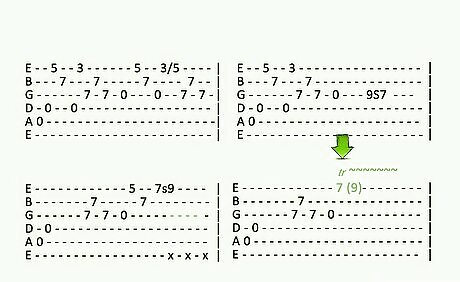
Learn the symbol for trills. When you see a "tr" written in or above the tab, it's usually between (or above) two notes. Often, it's accompanied by a string of tildes ("~'s.") This simply means to strike the first note, then rapidly hammer on to the second note and pull off to the first note again and again.
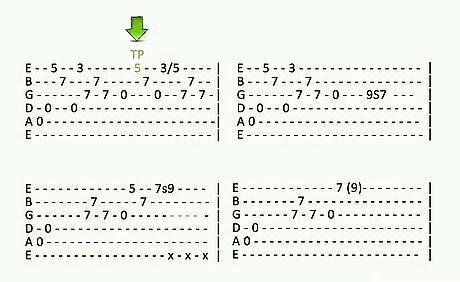
Learn the symbol for tremolo picking. "TP" means you should tremolo pick the note - essentially, pick the single note over and over as rapidly as you can. Sometimes, a TP symbol is followed by a string of tildes or dashes to give you a sense of how long to tremolo pick.
Reading an Example Tab
Glance over the tab below. Notice that it shows several three-note chords as well as some individual notes descending on the higher strings. In the following steps, we'll walk through this tab beat-by-beat. E---------------3-0--------------------|| B-------------------3-0----------------|| G---7-7-7---------------2-0------------|| D-2-7-7-7-7-7-7------------------------|| A-2-5-5-5-7-7-7------------------------|| E-0-------5-5-5------------------------||
Start with the chord at the far left. In this case, first you would play a power chord in E (Middle finger/Finger 2 on the second fret on the A string, ring finger/Finger 3 on the second fret on the D string, and no finger on the low E string) strumming those first 3 strings (E,A,D) once. Play the chord highlighted with parentheses below: E-------------3-0-----------------|| B----------------3-0--------------|| G-----777-----------2-0-----------|| D-(2)-777--777--------------------|| A-(2)-555--777--------------------|| E-(0)------555--------------------||
Proceed to the next two chords. The next chord you would play would be a power chord on the fifth fret of A three times. So you would play with your index finger on the fifth fret of A, your middle finger on the seventh fret of D, and your ring finger on the seventh fret of G. Then, simply shift this finger shape down one string so that your index finger is on the fifth fret of the E string with your other fingers on the seventh frets of the A and D strings. Play the chords in the sequence that they're highlighted with parentheses below: E-------------3-0-----------------|| B----------------3-0--------------|| G----(7)77-----------2-0----------|| D-2--(7)77--777-------------------|| A-2--(5)55--777-------------------|| E-0---------555-------------------|| E---------------3-0---------------|| B------------------3-0------------|| G----7(7)7------------2-0---------|| D-2--7(7)7--777-------------------|| A-2--5(5)5--777-------------------|| E-0---------555-------------------|| E---------------3-0---------------|| B------------------3-0------------|| G----77(7)------------2-0---------|| D-2--77(7)--777-------------------|| A-2--55(5)--777-------------------|| E-0---------555-------------------|| E---------------3-0---------------|| B------------------3-0------------|| G----777--------------2-0---------|| D-2--777--(7)77-------------------|| A-2--555--(7)77-------------------|| E-0-------(5)55-------------------|| E---------------3-0---------------|| B------------------3-0------------|| G----777--------------2-0---------|| D-2--777--7(7)7-------------------|| A-2--555--7(7)7-------------------|| E-0-------5(5)5-------------------|| E---------------3-0---------------|| B------------------3-0------------|| G----777--------------2-0---------|| D-2--777--77(7)-------------------|| A-2--555--77(7)-------------------|| E-0-------55(5)-------------------||
Play the individual notes at the right. After the first 3 chords in the example, proceed to the right and play the single notes. Put any finger on the third fret of the high E string, pluck once, then play the open high E string, and so on through the six descending notes. Play the notes below in the order they're highlighted in parentheses: E---------------(3)-0-------------------|| B--------------------3-0----------------|| G---7-7-7----------------2-0------------|| D-2-7-7-7-7-7-7-------------------------|| A-2-5-5-5-7-7-7-------------------------|| E-0-------5-5-5-------------------------|| E---------------3-(0)-------------------|| B--------------------3-0----------------|| G---7-7-7----------------2-0------------|| D-2-7-7-7-7-7-7-------------------------|| A-2-5-5-5-7-7-7-------------------------|| E-0-------5-5-5-------------------------|| E---------------3-0---------------------|| B--------------------(3)-0--------------|| G---7-7-7------------------2-0----------|| D-2-7-7-7-7-7-7-------------------------|| A-2-5-5-5-7-7-7-------------------------|| E-0-------5-5-5-------------------------|| E---------------3-0---------------------|| B--------------------3-(0)--------------|| G---7-7-7------------------2-0----------|| D-2-7-7-7-7-7-7-------------------------|| A-2-5-5-5-7-7-7-------------------------|| E-0-------5-5-5-------------------------|| E---------------3-0---------------------|| B--------------------3-0----------------|| G---7-7-7----------------(2)-0----------|| D-2-7-7-7-7-7-7-------------------------|| A-2-5-5-5-7-7-7-------------------------|| E-0-------5-5-5-------------------------|| E---------------3-0---------------------|| B--------------------3-0----------------|| G---7-7-7----------------2-(0)----------|| D-2-7-7-7-7-7-7-------------------------|| A-2-5-5-5-7-7-7-------------------------|| E-0-------5-5-5-------------------------||
Put it all together. Play the chords and notes from left to right without stopping. Tap your foot, playing each note or chord on each tap of your foot. Work slowly and carefully, only increasing your speed once you've mastered playing the tab slowly.




















Comments
0 comment